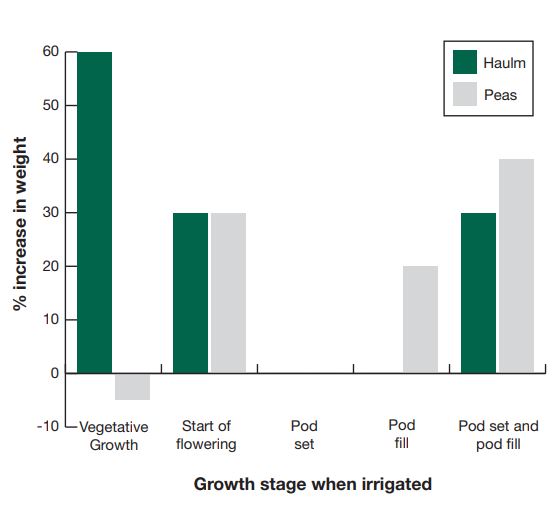Please click here to access the main AHDB website and other sectors.
- Home
- Knowledge library
- Irrigation in vining peas: timing
Irrigation in vining peas: timing
To get the full benefit of irrigation during the different growth stages of your vining peas crop, timing is crucial.
This information was last updated in 2012.
Timing of irrigation in vining peas: early season
Do not irrigate before flowering unless necessary to help seeds germinate or relieve drought.
Irrigation at the vegetative stage
Soils are usually near to field capacity when peas are sown.
Irrigating before the start of flowering increases haulm (stalk/stem) weight but rarely increases yield.
Affect on yield
In several experiments, irrigation during vegetative growth depressed pea yields.
Your crop should not be irrigated during the vegetative stage unless the seedbed is so dry that adequate germination would not otherwise happen, or if drought has severely wilted the crop.
Irrigation at the start of flowering
Peas are most responsive to irrigation when the first flowers are opening. If a single irrigation is to be done, it should be at this stage.
Yield
The plant is thought to be most responsive now because the root system has ceased to grow and will be more vulnerable to a lack of water.
Yield increases from irrigation at this time are often very substantial, as much as 50%, as more peas per pod are formed. Haulm weight also increases.
Timing of irrigation in vining peas: late season
Irrigation during late flowering will not increase yield and may increase the risk of disease.
Irrigating at pod fill may increase your yield by as much as 20%.
This increase is the result of irrigating at both pod set and pod fill, rather than at pod set alone.
Be aware that irrigation at pod fill can set maturity back by two days.
Irrigation at late flowering, or ‘petal fall’
Irrigation at this stage does not result in yield increases. It has no effect on the weight, the number of pods per plant or the number of peas per pod.
Haulm weight is also unlikely to be affected. A slight renewal of root growth occurs during this period which may explain the lack of response.
Irrigation at petal fall may increase the likelihood of Botrytis cinerea infection in the damp, moribund petals.
If inoculum is present, there may also be a greater risk of Sclerotinia sclerotiorum if you increase humidity by irrigating.
Irrigation at pod fill
Crops irrigated during pod fill, when vining pea crops are at tenderometer (TR) readings of between 70 and 90, have shown considerable increases in yield, sometimes up to 20%.
The number of peas per pod and the mean weight of peas are increased by irrigating at this time. The weight of haulm is not affected.
The average increases in the total weight of haulm and of shelled peas are shown in this graph, a summary of results from nine years of experiments carried out at Wellesbourne.
Figure 1. Response to irrigation in vining peas
Other consequences of irrigation at pod set and fill
Although irrigation at pod set appears to have little influence on its own, your yields may improve and haulm weight increase by an additional 15-20% if a second irrigation is done at pod fill, compared to irrigation at pod fill only.
This approach, however, puts an increased pressure on irrigation equipment which may be required elsewhere on farm.
Other effects of irrigation
You should also take into account that while irrigating during vegetative growth and early flowering has been found to have little effect on the rate of maturation, irrigation during pod fill, when the average TR is approximately 80, delays the maturity of vining peas by approximately two days.
This effect is predictable and consistent and must be taken into account in vining pea crop succession during vining.
When adequate moisture is available there will be little advantage in using irrigation, in fact too much water can result in foot-rot symptoms.
Original author
James Scrimshaw, PGRO
Topics:
Sectors:
Tags:


